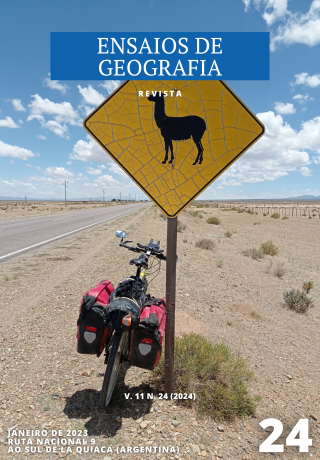Guerra Urbana em Gaza
100 dias de combate entre Israel e Palestina
DOI:
https://doi.org/10.22409/eg.v11i24.61784Palavras-chave:
Guerra urbana, Faixa de Gaza, Israel, Hamas, Espaço de batalhaResumo
Este artigo analisa o emprego de táticas, tecnologias e abordagens de guerra urbana entre Israel e a resistência palestina, cuja principal facção é o Hamas, sitiada na Faixa de Gaza, ao longo de cem dias de combate, entre outubro de 2023 e janeiro de 2024. Para efeito de estudo, o artigo realiza uma abordagem dialética das trajetórias dos grupos armados em conflito no espaço urbano da Faixa de Gaza com o propósito de compreender as dinâmicas espaciais implicadas no espaço de batalha. Dessa maneira, busca, por meio da análise comparativa de interpretação socioespacial/territorial do conflito, evidenciar as concepções de combate aplicadas no terreno a partir das táticas e formas de organização do território, bem como os respectivos meios militares empregados. As dinâmicas espaciais dos grupos armados em disputa no território configuram o espaço de batalha ordenado por múltiplas camadas espaciais. Com enfoque nas táticas dos grupos em combate no espaço urbano da Faixa de Gaza, observa-se que Israel opera por meio do urbicídio, pratica que consiste na destruição deliberada do espaço urbano enquanto política de guerra. Por sua vez, os grupos palestinos, em sua luta insurgente, usam do ambiente urbano para organizar suas ações de resistência em situação de combate urbano.
Downloads
Referências
ABUJIDI, N. Urbicide in Palestine: spaces of oppression and resilience. Nova York: Routledge, 2014.
COWARD, M. Urbicide in Bosnia. In: GRAHAM, S. (Org.). Cities, war and terrorism: towards an urban geopolitics. Oxford: Blackwell Publishing Ltd., 2004, p. 154-171.
COWARD, M. Urbicide: the politics of urban destruction. Nova York: Routledge, 2009.
CHIODELLI, F. Urbicide, neo-colonial subjugation and the Gaza Strip. Political Geography, v. 94, n. 102534, p. 1-3, 2022.
FREGONESE, S. The urbicide of Beirute? Geopolitics and the built environment in the Lebanese civil war (1975–1976). Political Geography, v. 28, p. 309-318, 2009.
GRAHAM, S. Cities as strategic sites: places annihilation and urban geopolitics In: GRAHAM, S. (Org.). Cities, war and terrorism: towards an urban geopolitics. Oxford: Blackwell Publishing Ltd., 2004a. p. 31-53.
GRAHAM, S. Constructing urbicide by bulldozer in the occupied territories. In: GRAHAM, S. Cities, war and terrorism: towards an urban geopolitics. Oxford: Blackwell Publishing Ltd., 2004b. p. 192-213.
GRAHAM, S. Vertical geopolitics: Baghdad and after. Antipode: a radical journal of geography, v. 36, p. 12-23, 2004c.
GRAHAM, S. Cities under siege: the new military urbanism. Londres: Verso, 2011.
HAESBAERT, R. Desterritorialização: entre as redes e os aglomerados de exclusão. In: CORRÊA, R. L.; GOMES, P. C. C.; CASTRO, I. E. (Orgs.). Geografia: conceitos e temas. 12. ed. Rio de Janeiro: Bertrand Brasil, 2009, p. 165-205.
HAESBAERT, R. O mito da desterritorialização: do “fim dos territórios” à multiterritorialidade. 3. ed. Rio de Janeiro: Bertrand Brasil, 2007.
HAESBAERT, R. Viver no limite: território e multi/transterritorialidade em tempos de in-segurança e contenção. Rio de Janeiro: Bertrand Brasil, 2014.
MENDONÇA, M. J. Espaço de batalha e urbicídio na cidade do Rio de Janeiro. São Paulo: Editora Dialética, 2022.
MORAG, N. Urban warfare: the recent Israeli experience. Journal of Strategic Security, v. 16, n. 3, p. 78-99, 2023.
O labirinto de túneis em Gaza que o Hamas diz ser maior que o metrô de Londres. BBC News Brasil, 13 de outubro de 2023. Disponível em: https://www.bbc.com/portuguese/articles/c4nv2y7erx5o. Acesso em: 13 de out. 2023.
Os colonos judeus que planejam construir assentamentos na orla de Gaza. BBC News Brasil, 25 de março de 2024. Disponível em: https://www.bbc.com/portuguese/articles/c72dn1471p2o. Acesso em: 25 de mar. 2024.
SHARP, D. Urbicide and the arrangement of violence in Syria. In: SHARP, D.; PANETTA, C. (Orgs.). Beyond the square: urbanism and the Arab Uprisings. New York: Urban Research, 2016, p. 118-140.
SHAW, M. New wars of the city: relationship of “urbicide” and “genocide”. In: GRAHAM, S. (Org.). Cities, war and terrorism: towards an urban geopolitics. Oxford: Blackwell Publishing Ltd., 2004, p. 141-153.
SPENCER, J. The eight rules of urban warfare and why we must work to change them. Modern War Institute, 1º de dezembro de 2021. Disponível em: <https://mwi.usma.edu/the-eight-rules-of-urban-warfare-and-why-we-must-work-to-change-them/>. Acesso em: 6 de janeiro de 2024.
‘Teia de aranha’: o emaranhado de túneis do Hamas que põe Israel no escuro, UOL (em parceria com Deutsche Welle), 20 de novembro de 2023, disponível em https://noticias.uol.com.br/internacional/ultimas-noticias/2023/11/20/o-emaranhado-de-tuneis-do-hamas-que-poe-israel-no-escuro.htm. Acesso em: 20 nov. 2023.
WEIZMAN, E. Hollow land: Israel’s architecture of occupation. Nova York: Verso, 2012.
WEIZMAN, E. Strategic points, flexible lines, tense surfaces, and political volumes: Ariel Sharon and the geometry of occupation. In: GRAHAM, S. (Org.). Cities, war and terrorism: towards an urban geopolitics. Oxford: Blackwell Publishing Ltd, 2004, p. 172-191.
WEIZMAN, E. The politics of verticality. Open Democracy. Londres, Inglaterra, texto de 11 partes disponibilizado entre 23 de abril e 1º de maio de 2002. Disponível em: http://www.opendemocracy.net/. Acesso em: 26 de mar. 2014.
Publicado
Edição
Seção
Licença
Copyright (c) 2024 Da Revista (Ensaios de Geografia) e do Autor

Este trabalho está licenciado sob uma licença Creative Commons Attribution 4.0 International License.
Atribuição CC BY. Esta licença permite que outros distribuam, remixem, adaptem e criem a partir do seu trabalho, mesmo para fins comerciais, desde que lhe atribuam o devido crédito pela criação original.


